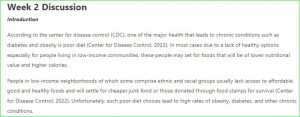Week 2 Discussion
Introduction
According to the center for disease control (CDC), one of the major health that leads to chronic conditions such as diabetes and obesity is poor diet (Center for Disease Control, 2022). In most cases due to a lack of healthy options especially for people living in low-income communities, these people may set for foods that will be of lower nutritional value and higher calories.
People in low-income neighborhoods of which some comprise ethnic and racial groups usually lack access to affordable good and healthy foods and will settle for cheaper junk food or those donated through food stamps for survival (Center for Disease Control, 2022). Unfortunately, such poor diet choices lead to high rates of obesity, diabetes, and other chronic conditions.
In the United States alone, there is a higher percentage of people that do not afford healthy food and will end up consuming foods that have too much sodium, sugar, and saturated fat which increases the risk of chronic conditions. Studies by CDC report that fewer than 1 in 10 adults and adolescents eat enough vegetables or fruits (Center for Disease Control, 2022). Also, 6 in 10 young people ages 2 to 19 and those ages 5 in 10 adults will consume about one sugary drink any given day.
Identification of the type of organizational assessment used
The type of organization assessment that I used was the health risk assessment, which is a screening tool that helps in understanding individual health risks and ensures the monitoring of the patient health status with time. I decided to use the health risk assessment tool since it provides better demographics in regard to various aspects of a particular condition (World Health Organisation, 2022).
The risk assessment tool will include a questionnaire, an assessment of the individual health status, and personalized feedback regarding individual actions that one can adopt to reduce the risks, prevent disease or maintain good health. A health risk assessment also includes questions like demographic characteristics, lifestyle behavior, emotional health, physical health, current, and past health conditions, and readiness to change behaviors to improve health.
Relevance of the assessment
The health risk assessment was carried out among low-income communities, as a way of creating awareness regarding the impact of poor diet in increased cases of heart conditions. The health risk assessment is relevant to the topic of study as it provides various individualized data which can be compared and gauge the major cause of chronic conditions, especially health diseases among people living in low-income neighborhoods (World Health Organisation, 2022).
The topic is the impact of poor food choices on the increased cases of heart disease among the Hispanic and black populations in the United States. The health risk assessment will be completed online using a smartphone, a PC, or a tablet. Also, those that will not be computer literate can be allowed to complete the assessment through hard copies with an assistant.
The biometric data will be collected and the hospital and feedback for these individuals will be done online as well. The health risk assessment will also be useful in assessing affordable healthcare, which can be shared also by organizations that provide population health that includes management services (World Health Organisation, 2022). With health risk assessment, the health institution will also be in a position to come up with programs that ensure the implementation of health programs to support a good diet.
References
Center for Disease Control. (2022, June 6). Poor nutrition. Centers for Disease Control and Prevention. https://www.cdc.gov/chronicdisease/resources/publications/factsheets/nutrition.htm
World Health Organisation. (2022). Health risk assessment. World Health Organization (WHO). https://www.who.int/teams/environment-climate-change-and-health/radiation-and-health/non-ionizing/risk-assessment
Also check: Discussion: Collaborative Activity 2: Research And Report Providing Feedback
